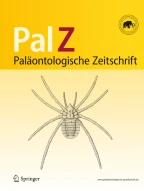We’re sorry, something doesn't seem to be working properly.
Please try refreshing the page. If that doesn't work, please contact support so we can address the problem.
Abstract
Palaeosaurus (?) diagnosticusHuene from the Stubensandstone (Upper Triassic, Norian) of Nordwürttemberg, Germany is made the type species of a new genus of prosauropod dinosaurEfraasia, which is referred to the family Anchisauridae. The anatomy ofEfraasia diagnostica is conservative and it was an ideal ancestor for the later and more specializedAnchisaurus polyzelus of North America. The slenderness of the manus and pes ofEfraasia andAnchisaurus is matched amongst prosauropods only by the feet ofGyposaurus capensis andThecodontosaurus antiquus. Staurikosaurus priceiColbert from the Upper Triassic of Brazil is probably a very primitive theropod dinosaur.
Zusammenfassung
Palaeosaurus (?) diagnosticusHuene aus dem Stubensandstein (Obere Trias, Norium) von Nordwürttemberg wird zur Typusart der neuen Prosauropoden-GattungEfraasia erhoben, die der Familie Anchisauridae zugeordnet wird. Die Anatomie vonEfraasia diagnostica zeigt altertümliche Züge und weist die Art als idealen Vorfahren des jüngeren und stärker spezialisiertenAnchisaurus polyzelus von Nordamerika aus. Der schwache Knochenbau von Hand und Fuß vonEfraasia läßt sich unter den Prosauropoden nur mit dem Fußskelett vonGyposaurus capensis undThecodontosaurus antiquus vergleichen.Staurikosaurus priceiColbert aus der Obertrias Brasiliens ist wahrscheinlich ein sehr primitiver Theropode.
This is a preview of subscription content,log in via an institution to check access.
Access this article
Subscribe and save
- Get 10 units per month
- Download Article/Chapter or eBook
- 1 Unit = 1 Article or 1 Chapter
- Cancel anytime
Buy Now
Price includes VAT (Japan)
Instant access to the full article PDF.
Similar content being viewed by others
Literature cited
Appleby, R. M., Charig, A. J., Cox, C. B., Kermack, K. A. &Tarlo, L. B. H. (1967): Reptilia. — In: The fossil record (ed.Harland, B. et al.), 695–731, Geological Society London.
Barker, R. T. (1971): Ecology of the brontosaurs — Nature,229, 172–174, London.
Berckhemer, F. (1938): Wirbeltierfunde aus dem Stubensandstein des Strombergs. — Naturwiss. Mh. »Aus der Heimat«,51, 188–198, Stuttgart.
Bonaparte, J. F. (1971): Annotated list of the South American Triassic tetrapods. — Proc. Second Gondwana Symp., 665-682, Pretoria.
Broom, R. (1906): On the South African dinosaur (Hortalotarsus). — Trans. S. Afr. Phil. Soc,16, 201–206, Cape Town.
—— (1911): On the dinosaurs of the Stormberg, South Africa. — Ann. S. Afr. Mus.,7, 291–308, Cape Town.
Charig, A. J., Attridge, J. &Crompton, A. W. (1965): On the origin of the sauropods and the classification of the Saurischia. — Proc. Linn. Soc. London,176, 197–221.
Colbert, E. H. (1964): Relationships of the saurischian dinosaurs. — Amer. Mus. Novitates, No. 2181, 24p., New York.
- (1970): A saurischian dinosaur from the Triassic of Brazil. — Amer. Mus. Novitates, No. 2405, 39p., New York.
Fraas, E. (1913): Die neusten Dinosaurierfunde der schwäbischen Trias. — Die Naturwissenschaften, I,45, 1097–1100, Stuttgart.
Galton, P. M. (1969): The pelvic musculature of the dinosaurHypsilophodon (Reptilia: Ornithischia) — Postilla, No. 131, 64 p., New Haven.
—— (1971): The prosauropod dinosaurAmmosaurus, the crocodileProtosuchus, and their bearing on the age of the Navajo Sandstone of northeastern Arizona. — J. Paläont.,45, 781–795, Tulsa.
—— (1972): Classification and evolution of ornithopod dinosaurs. — Nature,239, 464–466, London.
—— (1973): On the cheeks of ornithischian dinosaurs. — Lethaia,6, 67–89, Oslo.
- (In press): Prosauropod dinosaurs of North America. — Bull. Peabody Mus. Nat. Hist., New Haven.
Huene, F. V. (1907–08): Die Dinosaurier der europäischen Triasformation mit Berücksichtigung der außereuropäischen Vorkommnisse. — Geol. u. paläont. Abh. Suppl. 1, 419 p., Ill pls., Jena
- (1914): Saurischia et Ornithischia Triadica (»Dinosauria« Triadica). — In Fossilium Catalogus 1, Animalia, 4, 21p., Berlin.
—— (1932): Die fossile Reptil-Ordnung Saurischia, ihre Entwicklung und Geschichte. — Monogr. Geol. Paläont., (1),4, 361 p., 56 pls., Leipzig.
- (1956): Paläontologie und Phylogenie der niederen Tetrapoden. — 716 p., Jena.
Kuhn, O. (1959): Ein neuer Microsaurier aus dem deutschen Rotliegenden. — N. J. Geol., Paläont. Mh.,9, 424–426.
Lull, R. S. (1953): Triassic life of the Connecticut Valley. Revised edition. — Bull. Connecticut Geol. and Nat. Hist. Surv., No. 81, 331 p., Hartford.
Morris, J. (1843): A catalogue of British fossils. — 372 p., London.
Reig, O. A. (1963): La presencia de dinosaurios saurisquios en los »Estratos de Ischigualasto« (»Mesotriasico Superior«) de las provincias de San Juan y la Rioja (Republica Argentina). — Ameghiniana,3, 3–20, Buenos Aires.
Riley, H. &Stutchbury, S. (1836): A description of various fossil remains of three distinct saurian animals discovered in the autumn of 1834, in the Magnesian Conglomerate on Durdham Down, near Bristol. — Proc. Geol. Soc. London,2, 397–399.
—— (1840): A description of various fossil remains of three distinct saurian animals, recently discovered in the Magnesian Conglomerate near Bristol. — Trans. Geol. Soc. London,5, 349–357.
Seeley, H. G. (1895): OnThecodontosaurus and Palaeosaurus, — Ann. Mag. Nat. Hist., (6)15, 144–163, London.
Young, C. C. (1941):Gyposaurus sinensis (sp. nov.) a new prosauropod from the Upper Triassic Beds at Lufeng, Yunnan. — Bull. Geol. Soc. China,21, 205–253, Peking.
Author information
Authors and Affiliations
Department of Biology, University of Bridgeport, 06602, Bridgeport, Conn., USA
Peter M. Galton
- Peter M. Galton
You can also search for this author inPubMed Google Scholar
Rights and permissions
About this article
Cite this article
Galton, P.M. On the anatomy and relationships ofEfraasia diagnostica (Huene) n. gen., a prosauropod dinosaur (Reptilia: Saurischia) from the Upper Triassic of Germany.Paläontol. Z.47, 229–255 (1973). https://doi.org/10.1007/BF02985709
Issue Date:



